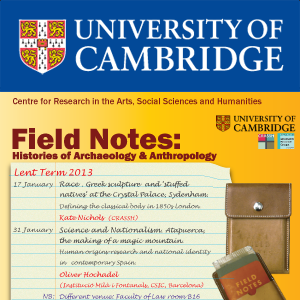Field Notes - 9 May 2013 - Cultural Evolution: Interpreting the Art of the Old Stone Age and the Origins of Human Nature, 1870-1940
Duration: 1 hour 43 mins
Share this media item:
Embed this media item:
Embed this media item:
About this item

| Description: |
Chris Manias (University of Manchester).
Discussant: Professor Peter Mandler (Prof. of Modern Cultural History, Gonville & Caius College, Cambridge) Abstract The discovery of Palaeolithic art in western, southern and central Europe in the late-nineteenth and early-twentieth centuries was one of the most striking developments within the new and publicly prominent scholarly field of human prehistory, with implications which cut across the archaeological, anthropological and cultural sciences, and into wider popular discourse. At La Madeleine, Les Eyzies, Altamira, Dolní Věstonice, and a host of other sites, rock-paintings, carved bones and antlers, and statuettes were discovered depicting long-extinct animals, abstract designs and a few rare human figures. More than anything else, the art of the Upper Palaeolithic seemed to offer an insight into the mysterious world of the Ice Age, and potentially the origins and earliest development of human culture. Yet within this interest, individuals from a range of fields – including anthropologists, archaeologists, neurologists, art historians, literary figures, and public intellectuals – were split and divided over what these objects showed. Were these the first glimmerings of religious or ceremonial activity? The products of a pristine and natural form of human nature, which modernity was in danger of effacing? The sudden fully-formed flowering of “Neanthropic Man”? Manifestations of the simultaneously savage and child-like earliest condition of the human race? Or simply crude modern fakes within a field persistently dogged by frauds and forgeries? Examining the answers given to these questions as Palaeolithic art sparked excitement and debate across Europe and North America, this paper will examine not only the public and scholarly construction of European prehistory in the early-twentieth century, but also wider international debates on the development of human nature and culture. |
|---|
| Created: | 2013-05-17 09:03 |
|---|---|
| Collection: | Field Notes Seminar |
| Publisher: | University of Cambridge |
| Copyright: | Glenn Jobson |
| Language: | eng (English) |
| Keywords: | Field Notes; CRASSH; |
| Abstract: | Chris Manias (University of Manchester).
Discussant: Professor Peter Mandler (Prof. of Modern Cultural History, Gonville & Caius College, Cambridge) Abstract The discovery of Palaeolithic art in western, southern and central Europe in the late-nineteenth and early-twentieth centuries was one of the most striking developments within the new and publicly prominent scholarly field of human prehistory, with implications which cut across the archaeological, anthropological and cultural sciences, and into wider popular discourse. At La Madeleine, Les Eyzies, Altamira, Dolní Věstonice, and a host of other sites, rock-paintings, carved bones and antlers, and statuettes were discovered depicting long-extinct animals, abstract designs and a few rare human figures. More than anything else, the art of the Upper Palaeolithic seemed to offer an insight into the mysterious world of the Ice Age, and potentially the origins and earliest development of human culture. Yet within this interest, individuals from a range of fields – including anthropologists, archaeologists, neurologists, art historians, literary figures, and public intellectuals – were split and divided over what these objects showed. Were these the first glimmerings of religious or ceremonial activity? The products of a pristine and natural form of human nature, which modernity was in danger of effacing? The sudden fully-formed flowering of “Neanthropic Man”? Manifestations of the simultaneously savage and child-like earliest condition of the human race? Or simply crude modern fakes within a field persistently dogged by frauds and forgeries? Examining the answers given to these questions as Palaeolithic art sparked excitement and debate across Europe and North America, this paper will examine not only the public and scholarly construction of European prehistory in the early-twentieth century, but also wider international debates on the development of human nature and culture. |
|---|---|

